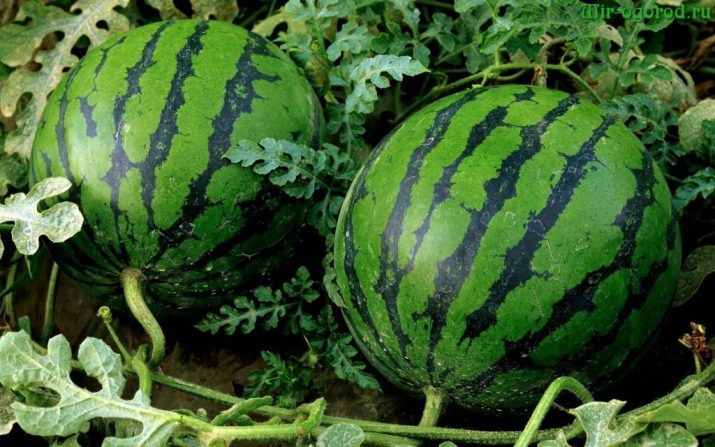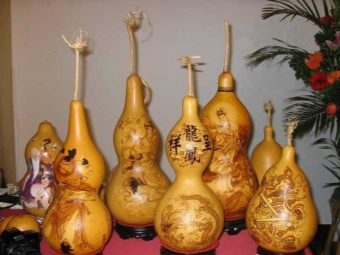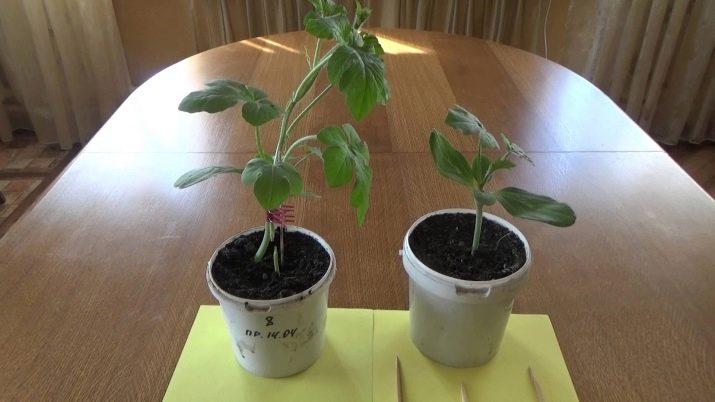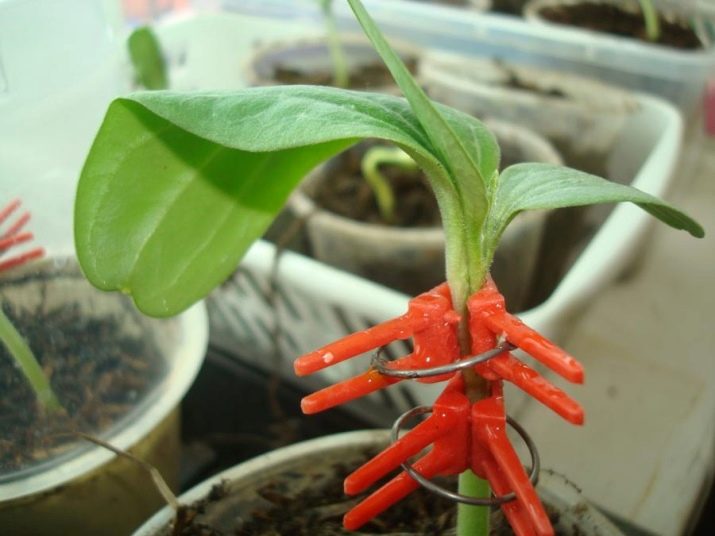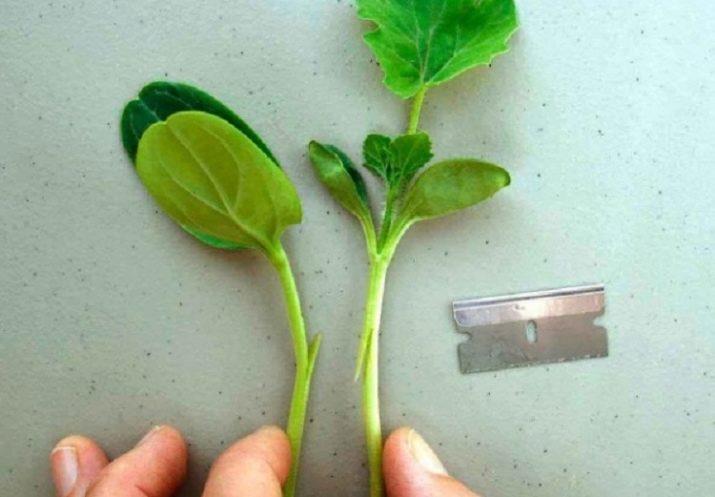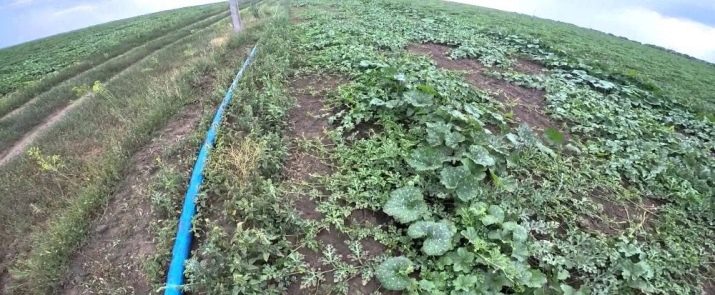Features of grafting watermelon on a pumpkin

A considerable number of gardeners wants to grow a watermelon on their land. But not everyone has the proper conditions for this.For example, a cold climate, overcast or danger of infection of the root system can negate all efforts. But there is a way out! If you plant watermelon in a pumpkin, then you can solve not only these, but also a number of other important problems.
Why do you need it?
It is not difficult to guess that it is possible to inoculate not only apples and pears, but also any related crops. This is done mainly to increase the resistance of the plant to adverse conditions and improve the quality of the crop. Watermelon is no exception. By instilling it on a resistant pumpkin, you can make your life much easier during the cultivation of the berries.
The main advantage of a grafted plant will be less susceptibility to cold. Watermelon will not tolerate a prolonged decrease in soil temperature below + 15 ° C. And such conditions are not uncommon in central Russia. Grafted onto a pumpkin, he will be able to withstand drops to + 10 ° C, and according to some reviews, to + 7 ° C. In addition to problems with temperature, grafting solves another difficulty. If at the place of cultivation for a long time cloudy weather prevails, the watermelon stops increasing the mass of its fruits and goes into the ripening process. In grafted berries this does not occur. The fruits are increasing, despite the weather.
But plants also improved in this way rarely suffer from Fusarium. This disease affects the root system of many melons, including watermelon. But the pumpkin is one of the few representatives of its kind, who is not afraid of Fusarium, which explains this resistance in grafted watermelon.
But that's not all. Pumpkin has a more extensive root system, going deeper than the original watermelon. From here several advantages follow:
- during the dry season, the plant will suffer less damage, as it can extract water from the lower layers of the soil;
- the poor land will have a good harvest thanks to the possibility of finding additional sources of food.
Choice of a grade of a stock
Before talking about the ideal option for the stock, in fairness it should be said that any pumpkin will do. But for obtaining large fruits and fast ripening, the Lagenaria pumpkin variety is best suited. This plant, imported from tropical countries, is characterized by rapid growth. And if you had to see dishes from pumpkins or playing instruments, then, most likely, it was Lagenariya.
Instruments
To produce high-quality grafting can not do without a sharp blade. The most affordable way to obtain it is the analysis of the old razor. If it is inconvenient to wield them, or there is a fear of injury, it is worth wrapping one end of the blade with a cloth or tape. In addition, you will need a rope 1-2 mm in diameter or a special graft clip. The purpose and method of their use will be described below in the article.
To do without mistakes, you should immediately say that you should not use an ordinary kitchen knife instead of a blade. After all, for a successful vaccination, it is necessary to ensure maximum contact between the cuts of two plants. And the knife will not so much cut off as it remembers the delicate stem of the sprout. Thereby disrupts the circulation of fluid inside the growing plants. And the work done will be wasted, because after such a great chance of the death of two plants at once.
Another precautionary measure is to handle the blade with a disinfectant. If this is not done, there is a risk of infecting the plants, which will condemn them to death in such a vulnerable position.
Ways
In order to vaccinate correctly, there are several ways. From the simplest that the inexperienced gardener can handle, to more advanced methods, popular among experienced professionals.
Convergence
To begin with, take the shoots of pumpkin and watermelon with two formed these leaves. In an amicable way, you should immediately make sure that the sprouts develop in close proximity to each other.Then, with a sharp blade, the top layer of the peel on the inside of the stem of both plants is gently scraped off. This is done at a distance of about half a centimeter from the cotyledon leaves. Then the sprouts are joined together and fastened together with something. For example, a rope, foil or graft clip.
A week later, you need to squeeze the stem of the watermelon below the bonding point. Here you can do without tools. Just squeeze it between your fingers to a characteristic crunch. But, of course, do not seek to crush him at all. You can squeeze again after a couple of days if necessary. The watermelon root will wither and go completely to the pumpkin root system. And after planting in open ground, you need to complete the procedure, getting rid of pumpkin shoots, so that they do not take additional food on themselves.
Tongue
This is perhaps the most common grafting scheme among gardeners. And this is understandable, because the method is characterized by a high percentage of successful operations and relative ease of execution. Here, as in the method discussed above, first 2 nearby germs are necessary, having already formed real leaves. On the sprout of the pumpkin below the top a couple of centimeters is cut from top to bottom. At the same time, starting from the edge of the stem, the movement of the blade goes diagonally to the middle. You should not cut a lot, it is enough 1 cm per din. After the stalk should be like a tongue.
Then the same is done with the second plant, but the direction of the blade goes already diagonally upwards. So that the tongue of one germ could be inserted into the cut of the other.
When the stock is grafted into a lock, their position is fixed. To do this, you can use the rope, gently tying two plants together, or use a special clip. So, sprouts do not touch another 3-4 days. Then the watermelon, by analogy with the previous method, pinch the stem. After another week and a half, the watermelon completely switched to the pumpkin root system, its stem is cut.
In split
If the two past methods differed in gradual grafting of watermelon, then this is more radical. And, accordingly, it is easier to make a mistake here, so for beginners this is not the best method.
And it consists in the following: a pumpkin sapling is taken, in which the real leaves have only outlined their growth, but the cotyledon has already spread out. Watermelon is taken with two already developed true leaves. Then a pointed object like an awl or a medical syringe is used to make a series of shots in the middle of a pumpkin sprout. Thereby removing the first true leaflets, and with them the so-called growth point. After you need to make a small incision from the top down the center. The resulting cleft in length should be in the region of 1.5 cm.
When finished with a pumpkin, it is better to quickly begin preparing a watermelon seedling. It must be cut at an oblique angle and then inserted into the pumpkin cut. The United shoots are fixed together and await the healing of wounds resulting from the operation.
Butt
Another radical method, similar in nature to the previous one. For its realization, 2 germs are needed, in which the first true leaflets have already been formed. In a pumpkin seedling, a through cut is made all the same 1.5 cm in length. A watermelon sprout, cut at an oblique angle, is placed in the pumpkin cut that appears so that nothing protrudes from the other edge.
The procedure is performed at a fast pace, so that the areas exposed by the blade do not have time to oxidize in air. After the shoots need to fix.
But it will be difficult to do this with the help of a rope, so it is recommended to use a graft clip. When the plants grow together safely, the top of the pumpkin is cut off.
Care
No matter how well the grafting procedure is carried out, without further care, all efforts can be in vain. For convenience, the above four methods can be divided into two groups.
The first, where the plants gradually adapt to the new conditions (approach and reed) and the second, where dramatic changes occur (splitting and butt). The first group with their further cultivation will not have any special problems. Since after the procedure, it is still 2 plants that can continue to feed using their own root systems.
Therefore, while the process of splicing is going on, sprouts will need only the sun, moderate watering and a stable temperature (+ 25-29 degrees during the day and no less than +15 at night).
In the second group, the process of leaving is somewhat more complicated. Due to the fact that the cut watermelon sapling will not be able to get water naturally, you will need to help him in this. To do this, after the operation, the plant is placed under a transparent dome, as which you can use a glass jar, a plastic bottle without a bottom or a plastic bag. Moisture will circulate inside this greenhouse, saturating the air.
Thus, the graft will not experience a water shortage. And after five days, the dome can already be removed for a few minutes a day for airing, increasing the time every day. Such a greenhouse will be needed within two weeks. Approximately so much time is required to merge a watermelon with a pumpkin sprout.
But creating favorable conditions with high humidity, there is a high risk of infection with mold. Therefore, working with the second group, it is necessary to pay special attention to the purity of the tool used. But also it is impossible to forget about the soil where the not strong plant will grow. The earth must first be decontaminated in order to avoid further complications.
And finally, to minimize the meeting with the mold, you need to control the humidity. Its excess will also negatively affect the result. Therefore, if there is an excessively large amount of condensate on the inner surface of the greenhouse, the ventilation should take longer. And as a result of everything, following these recommendations, even a novice gardener will succeed in this, at first glance, difficult, but useful work.
For how to inoculate a watermelon on a pumpkin, see the following video.


